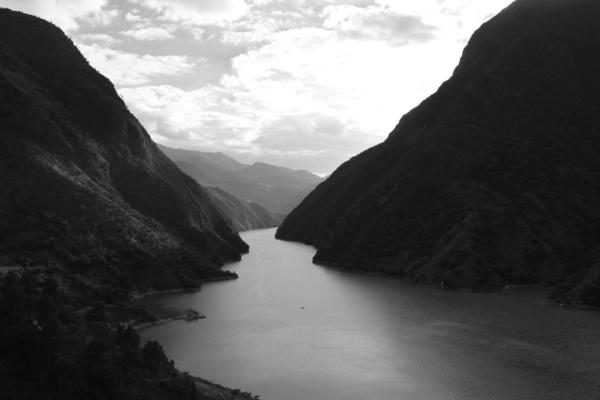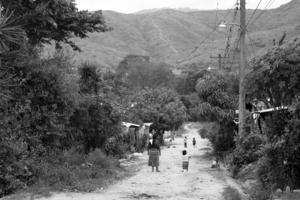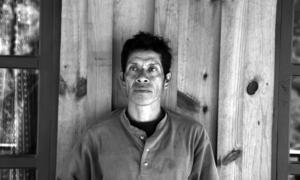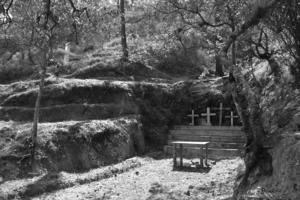
In the cool grey dawn at Río Negro, a small Guatemalan village, Sebastian Iboy Osorio and his companions walk the steep sandy paths to the water, and wait. Inside the homes, women dressed in their finest huipiles and skirts work the yellow corn dough in their hands, carefully stacking the tortillas into covered baskets. From the wooded ravines and open fields comes the sound of mourning doves and the laughter and whistles of children playing.
I’m writing this on March 13, and over the next few hours the residents of this isolated community will receive hundreds of guests: survivors, just like them, of a massacre that took place 32 years ago to the day.
One of over 600 villages wiped off the map between 1978 and 1982—the height of Guatemala’s internal conflict—Río Negro was once a community of almost 800 Maya-Achi farmers, artisans, and fishermen. For generations the community existed along the river’s edge, worked the land, and traded with a string of other communities. And because of their independence and seclusion, they escaped much of the discrimination faced by other Mayan communities, whose lands and labor were usurped by the government after centuries of conquest and resistance.
Their lifestyle of local trade and relative seclusion changed abruptly one day in 1976, when members of the government-owned National Electrification Institute (INDE), showed up in a helicopter to serve an eviction notice.
“They told us we would have to leave, because of a dam they would build a few miles downstream,” Sebastian told me in a 2009 interview. Sebastian was only a teenager at the time.
In the years to follow many men would show up, from government officials, to archaeologists, to World Bank and Inter-American Development Bank (IADB) employees, who would later invest hundreds of millions of dollars into the megaproject called Chixoy—the name of the river that wound its way through the narrow valley and eventually to the Bay of Campeche in Mexico.
There were many promises made by the INDE regarding their relocation: guarantees of free electricity, better homes, and sufficient land to grow their milpa—the age-old Maya trilogy of corn, beans, and squash—the foundation of their nutritional and cultural sustenance.
Yet as the time grew closer to Río Negro’s imminent expulsion, as well as that of 23 other communities in the way of either the dam or its 30-mile long reservoir, it became evident that most of these promises would not be fulfilled.
It was in January 1980 that government workers led a handful of community leaders to the military-established “model village” of Pacux, a six-hour trek over the mountain from Río Negro, to catch a glimpse of life in relocation. They walked through the rows of cinderblock and wooden homes and noticed the hard-packed earth, the tight confines. In disbelief over the lack of access to arable land and water, the leaders returned to Río Negro, and in the following days they held community meetings to plan their response: either demand the fulfillment of original promises, or refuse to leave. In the end they would choose the latter, and pay dearly for it.
*
By midday the sun is oppressive and the wind that sweeps down the tawny, desiccated hills offers little relief. In a long circuitous procession, the men, women, children, and elderly begin their commemoration march three kilometers up the steep trail towards Pacoxom, where the massacre of their village took place—where 177 women and children were brutally murdered and left in a dry, open ditch on the side of the mountain pass, 32 years ago.

The violence came swiftly to Río Negro after the residents refused to leave. According to Carlos Chen Osorio, a leader at the time and key negotiator in the present reparations movement, the first assault occurred after the INDE accused two men from Río Negro of stealing beans at the dam site. When military police arrived at the village to investigate, a heated argument took place and the officers opened fire, killing seven. One officer was chased into the river by residents, and as many account, it was there that he drowned.
Shortly following this incident, two community representatives delivering the Libro de Actas—documents outlining compensation promises and land titles—to the INDE were found mutilated, the documents never to be found. “It was after this,” Carlos told me in a recent interview, “that we were labeled guerrillas. And this is how the war in Guatemala reached us here, in Río Negro.”
The history of the Guatemalan uprising—and the state-sponsored terror that followed in its wake—is complex, and the intensity of guerrilla and counterinsurgency activities varied from region to region. Like much of Central America, crises relating to a firmly entrenched export-driven economy and inequality between the landless and the elite, as well as a growing socialist movement to counter increased authoritarianism, resulted in widespread rebellions throughout the isthmus.
Although no single motive spurred the uprising and attempted revolution in Guatemala, some of its roots lie in the aborted agrarian reform under social democratic president Jacobo Árbenz Guzmán, who was deposed in 1954 in a CIA-orchestrated coup for his attempt to tax, expropriate, and allocate to landless peasants the vast lands unused by Boston-based giant United Fruit Company.
Following the coup, increased repression and a rollback of the progressive reforms established under Árbenz sparked a failed rebellion by a group of junior officers in 1960, initiating the 36-year-long armed insurgency.
Despite its beginnings, however, the revolutionary movement was hardly relegated to ex-military. As UC Santa Cruz professor Susanne Jonas explains it, “The ‘rebels’ were not simply those who took up arms, but were the unseen hundreds of thousands among Guatemala’s 87% majority who refused to accept a fate of poverty and discrimination.”
During the period of construction of the Chixoy Dam from 1976 to 1983—without a doubt the bloodiest point in the conflict—much of the nation experienced an unprecedented level of government repression to counter a growing unrest amongst the population. A combination of global economic crisis, a widening gap in wealth distribution, the lowering of wages (despite growth in GDP), and the earthquake of 1976, which left one million homeless and 23,000 dead, all reinvigorated popular movements that originated in the 1960’s.
On top of this, an increase in tension between plantation owners—who were experiencing a boom in commerce—and the landless peasant workforce generated favorable conditions for recruitment in the countryside by guerrilla groups. As Jonas puts it, the racism and exclusion that facilitated capital’s boundless growth in Guatemala had reached a “boiling point.”

The back-to-back regimes of General Fernando Romeo Lucas García (1978-82) and General Efraín Ríos Montt (1982-83) propelled the disappearances and massacres into genocidal proportions, especially in rural districts. Under these dictatorships—which enjoyed open support from the Reagan Administration—a scorched earth policy involving the razing of entire villages of suspected guerrillas or guerrilla sympathizers led to the annihilation of 626 primarily Mayan communities. The military also established civilian defense patrols (Patrullas de Autodefensa Civil—PAC) as a means of controlling the insurgency in rural districts. Up to one million men (mostly Maya) were eventually forced into the PACs, intended to be an extension of the army’s fear campaign.
The attacks on Río Negro—as well as the entire Chixoy hydroelectric megaproject—were symbolic of the era. As Guatemalan economist Luis Solano points out, the dam was not just a means to cheap energy in a time of oil insecurity, but rather “a symbol of a model of development that propelled the government of Lucas García, destined to satisfy the interests of the industrial bourgeoisie. Those interests were encrypted in the development of certain sectors that required the granting of secure electricity: oil, mining, maquilas, non-traditional exports, and free-trade zones.”
For the military government and their industrial partners—who were often one in the same, according to Solano—the farmers and fishermen of Río Negro represented an impediment to the progress of the nation. Their elimination would be the fastest, and cheapest, way to deal with the problem.
The massacre on March 13, 1982 was the second in a series of four that in total would result in the death of 444 individuals—over half the Río Negro community—and marked the final day that residents would stay in the village before it disappeared under the rising floodwaters behind the dam.
As Carlos explains, the harassment from both the soldiers and the PAC from the nearby village of Xococ had become so constant by this point that the men and older boys were sleeping outside the village.
“We had no idea that they would end up killing all the women and children,” he tells me from his current home in Pacux.
Following the final attack, survivors fled into the mountains where they lived for up to three years in hiding. “We lived off bark, raw fish, and insects,” an orphan named Maria tells me, who traveled around with other young boys and girls that managed to escape the mass murder and rape at Pocoxom.
Despite the fact that the INDE was now free to complete the dam—and did—the military continued to pursue remaining inhabitants on foot and by helicopter, ambushing them in the abandoned village of Los Encuentros on May 14 (92 killed, 15 women disappeared), and Agua Fria on September 14 (35 children killed).
Eventually, disease and starvation led the community to “surrender” beginning in 1983. Survivors arrived at the entrance gates of Pacux, which, at that point, constituted an army garrison. “We were tortured in the base, and forced to admit we were with the guerrillas,” recalls Sebastian, who himself spent 11 days bound to a filthy latrine.
Over time the remaining families trickled into Pacux, where most still remain today in debilitating poverty. Some left immediately after realizing that they would still be controlled and harassed by the military. They went to the sugarcane plantations at the coast or the shanties outside Guatemala City to eke out a living, much like the millions of other internal refugees.
Others, like Sebastian, would eventually reach their physical and mental limits in relocation, and in time decide to walk back over the mountain, to see what was left of the land of their birth.
*
From the deck of the Centro Histórico y Educativo, a fine wooden building perched high over the dark abyss of the Chixoy Reservoir, Sebastian and other inhabitants of today’s Río Negro relate to me their stories of loss and recuperation.
It was here in 1991—nine short years after the final massacre and subsequent relocation—that he and two other survivors arrived and decided to stay, even if it meant death, to live once again as independent Maya-Achi farmers, fishermen, and parents.

“When we first got back, we wept for what had happened,” he tells me. “And we were still scared. But little by little we rehabilitated. We figured out how to use the land again and brought our families.”
Today, over 100 people occupy the steep slopes above the historic village, farming corn and other crops, and raising their families. “It’s not like it used to be,” Sebastian says, looking down to the reservoir. “The best land was at the river’s edge. We had fruit trees—mango, peanut, citrus, jocote, papaya, among others—and we caught many species of fish. Now, it’s much harder, but it’s still better than life in Pacux. Here we have space for our milpas, and are free to develop our community as we wish.”
In time the new residents were able to build proper homes, a school, and a health clinic. Through the help of a German development group, they started the Centro Histórico, in which they receive guests and teach them their history and way of life, while also bringing much-needed income into the community.
While many who still remain in Pacux wish to return to Río Negro and the campesino livelihood they grew up with, some find the demons too overwhelming, and many simply cannot afford to make the move.
Others, like Carlos, have remained in Pacux to fight for justice and reparations from both the Guatemalan government and the development banks that funded the project.
Over the past ten years, through remarkable persistence, local groups have succeeded in two landmark achievements: a winning case at the Inter-American Court of Human Rights in November 2012, which obliged the Guatemalan state to pay each survivor a given amount and offer public apology; and the signing of the 2010 Reparations Agreement by former president Álvaro Colom, which would help rebuild every community impacted by Chixoy.
Sadly however, neither of these victories have been acted upon.
According to Carlos, “the political will just doesn’t exist in Guatemala. And the current president,” he claims, “an ex-general himself, does not want to admit what happened.”
Many international supporters, including Grahame Russell, director of the Canadian/American human rights organization Rights Action, believe that the development banks should also be held accountable for their part in funding Chixoy, which ended up a financial disaster due to widespread corruption and mismanagement.
“Both the World Bank and IADB knew what was going on in the 1980’s and turned a blind eye,” says Russell, who contends that together with the Guatemalan state, the banks profited from the illegal displacements and massacres and should be forced to comply with reparations demands.
*
Back at the commemoration in Río Negro, at Pacoxom, the sun has set and the first fires are lit. In the now-excavated grave, family members light candles and place photos on the soft pine duff, preparing for a night of commemoration and ceremony.
While it remains unclear whether this community will receive their much-deserved reparations—and whether justice will ever be served for those who committed it—there’s little doubt that the people of Río Negro will continue striving for a better life, and make their story heard.
“It’s our only duty as survivors,” Sebastian tells me, “to teach our children and grandchildren about what happened. And it’s our right to reclaim what was lost—our land, our culture, and our memory—through the courts, or by our own means.”
Nathan Einbinder is a writer, photographer, and current director of The Rio Negro Project, a non-profit that funds sustainable development projects in Pacux and the new community of Rio Negro.
Read the rest of NACLA's 2014 Summer Issue: "Reimagining Drug Policy in the Americas"

